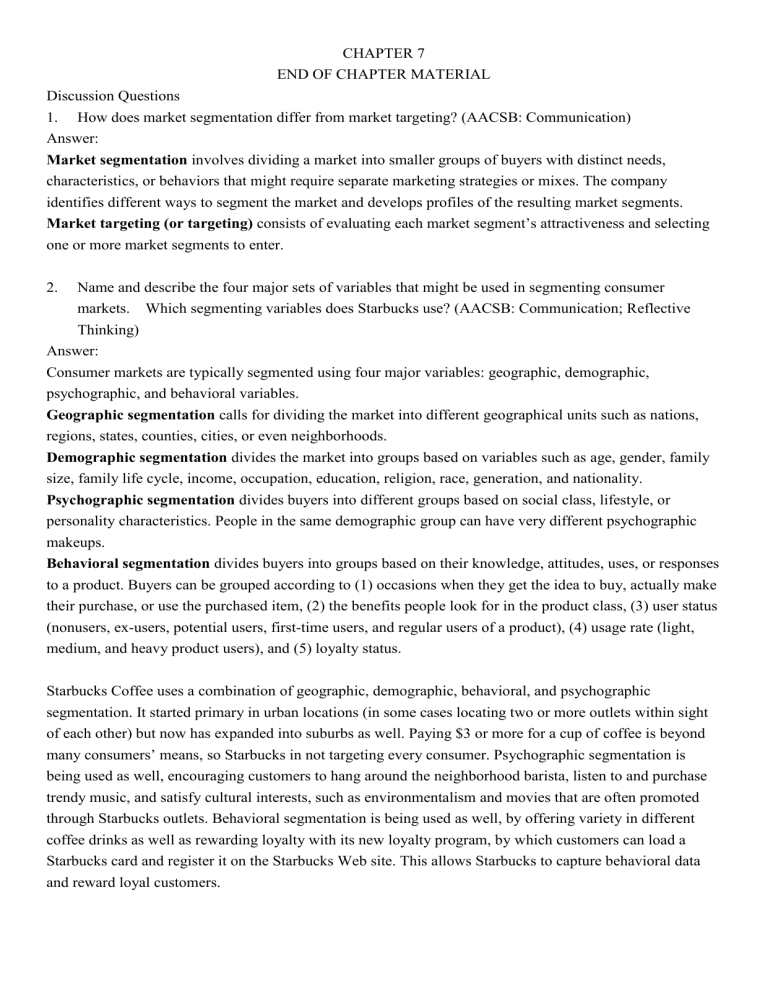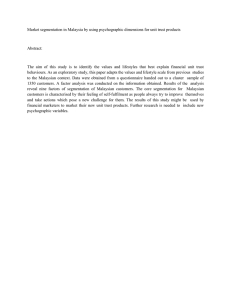
CHAPTER 7 END OF CHAPTER MATERIAL Discussion Questions 1. How does market segmentation differ from market targeting? (AACSB: Communication) Answer: Market segmentation involves dividing a market into smaller groups of buyers with distinct needs, characteristics, or behaviors that might require separate marketing strategies or mixes. The company identifies different ways to segment the market and develops profiles of the resulting market segments. Market targeting (or targeting) consists of evaluating each market segment’s attractiveness and selecting one or more market segments to enter. 2. Name and describe the four major sets of variables that might be used in segmenting consumer markets. Which segmenting variables does Starbucks use? (AACSB: Communication; Reflective Thinking) Answer: Consumer markets are typically segmented using four major variables: geographic, demographic, psychographic, and behavioral variables. Geographic segmentation calls for dividing the market into different geographical units such as nations, regions, states, counties, cities, or even neighborhoods. Demographic segmentation divides the market into groups based on variables such as age, gender, family size, family life cycle, income, occupation, education, religion, race, generation, and nationality. Psychographic segmentation divides buyers into different groups based on social class, lifestyle, or personality characteristics. People in the same demographic group can have very different psychographic makeups. Behavioral segmentation divides buyers into groups based on their knowledge, attitudes, uses, or responses to a product. Buyers can be grouped according to (1) occasions when they get the idea to buy, actually make their purchase, or use the purchased item, (2) the benefits people look for in the product class, (3) user status (nonusers, ex-users, potential users, first-time users, and regular users of a product), (4) usage rate (light, medium, and heavy product users), and (5) loyalty status. Starbucks Coffee uses a combination of geographic, demographic, behavioral, and psychographic segmentation. It started primary in urban locations (in some cases locating two or more outlets within sight of each other) but now has expanded into suburbs as well. Paying $3 or more for a cup of coffee is beyond many consumers’ means, so Starbucks in not targeting every consumer. Psychographic segmentation is being used as well, encouraging customers to hang around the neighborhood barista, listen to and purchase trendy music, and satisfy cultural interests, such as environmentalism and movies that are often promoted through Starbucks outlets. Behavioral segmentation is being used as well, by offering variety in different coffee drinks as well as rewarding loyalty with its new loyalty program, by which customers can load a Starbucks card and register it on the Starbucks Web site. This allows Starbucks to capture behavioral data and reward loyal customers. 3. Name and describe the levels at which market targeting can be carried out. Give an example of a company using each. (AACSB: Communication; Reflective Thinking) Answer: Market targeting can be carried out at several different levels. Companies can target very broadly (undifferentiated marketing), very narrowly (micromarketing), or somewhere in between (differentiated or concentrated marketing). Using an undifferentiated marketing (or mass marketing) strategy, a firm might decide to ignore market segment differences and target the whole market with one offer. Such a strategy focuses on what is common in the needs of consumers rather than on what is different. The company designs a product and a marketing program that will appeal to the largest number of buyers. Using a differentiated marketing (or segmented marketing) strategy, a firm decides to target several market segments and designs separate offers for each. Toyota Corporation produces several different brands of cars—from Scion to Toyota to Lexus—each targeting its own segments of car buyers. And P&G markets six different laundry detergent brands in the United States, which compete with each other on supermarket shelves. Using a concentrated marketing (or niche marketing) strategy, instead of going after a small share of a large market, a firm goes after a large share of one or a few smaller segments or niches. For example, Whole Foods thrives by catering to affluent customers that the Walmarts of the world can’t serve well. Micromarketing is the practice of tailoring products and marketing programs to suit the tastes of specific individuals and locations. Rather than seeing a customer in every individual, micromarketers see the individual in every customer. Micromarketing includes local marketing and individual marketing. For example, Harley-Davidson’s H-D1 factory customization program lets customers explore some 8,000 ways to “configure a Harley-Davidson motorcycle to create your own masterpiece—a truly one-of-a-kind ride. 4. Explain how companies segment international markets. (AACSB: Communication) Answer: Companies can segment international markets using one or a combination of several variables. They can segment by geographic location, grouping countries by regions such as Western Europe, the Pacific Rim, the Middle East, or Africa. Geographic segmentation assumes that nations close to one another will have many common traits and behaviors. World markets can also be segmented on the basis of economic factors. Countries might be grouped by population income levels or by their overall level of economic development. A country’s economic structure shapes its population’s product and service needs and, therefore, the marketing opportunities it offers. Countries can also be segmented by political and legal factors such as the type and stability of government, receptivity to foreign firms, monetary regulations, and amount of bureaucracy. Cultural factors can also be used, grouping markets according to common languages, religions, values and attitudes, customs, and behavioral patterns. Segmenting international markets based on geographic, economic, political, cultural, and other factors assumes that segments should consist of clusters of countries. However, as new communications technologies, such as satellite TV and the Internet, connect consumers around the world, marketers can define and reach segments of like-minded consumers no matter where in the world they are. Using intermarket segmentation (also called cross-market segmentation), they form segments of consumers who have similar needs and buying behaviors even though they are located in different countries. 5. Explain how a company differentiates its products from competitors’ products. (AACSB: Communication) Answer: A company can differentiate itself from competitiors along the lines of product, services, channels, people, or image. Through product differentiation, brands can be differentiated on features, performance, or style and design. Beyond differentiating its physical product, a firm can also differentiate the services that accompany the product. Some companies gain services differentiation through speedy, convenient, or careful delivery. Firms that practice channel differentiation gain competitive advantage through the way they design their channel’s coverage, expertise, and performance. Companies can also gain a strong competitive advantage through people differentiation—hiring and training better people than their competitors do. Even when competing offers look the same, buyers may perceive a difference based on company or brand image differentiation. A company or brand image should convey a product’s distinctive benefits and positioning. Developing a strong and distinctive image calls for creativity and hard work. 6. In the context of marketing, what is a product’s “position”? How do marketers know what it is? (AACSB: Communication) Answer: A product’s position is the way the product is defined by consumers on important attributes—the place the product occupies in consumers’ minds relative to competing products. Marketers often prepare perceptual positioning maps to show consumer perceptions of their brands versus competing products on important buying dimensions. Figure 7.3 is an illustration, and the position of each circle on the map indicates the brand’s perceived positioning on two dimensions and the size of each circle indicates the brand’s relative market share. Students should understand that marketers actively try to influence a product’s position through their selection of a differentiation and positioning strategy.








